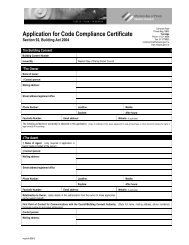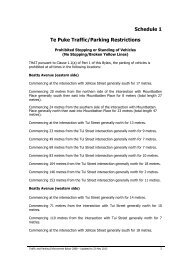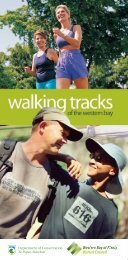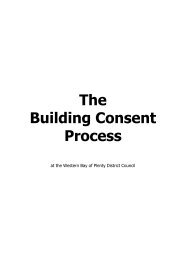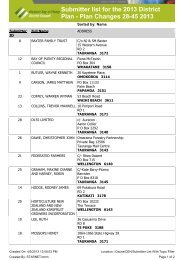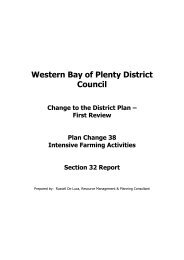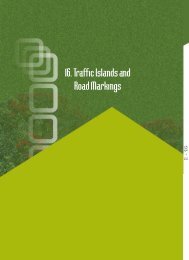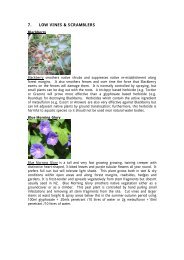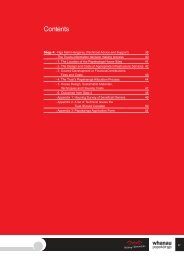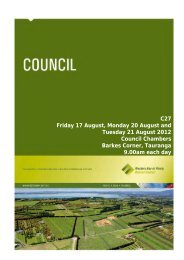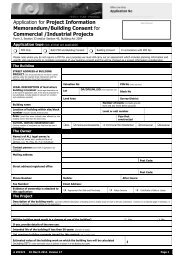Steps 1 and 2 - Western Bay of Plenty District Council
Steps 1 and 2 - Western Bay of Plenty District Council
Steps 1 and 2 - Western Bay of Plenty District Council
- No tags were found...
You also want an ePaper? Increase the reach of your titles
YUMPU automatically turns print PDFs into web optimized ePapers that Google loves.
Meaning <strong>of</strong> the cover“TE KITEPARAHA MO NGA PAPAKĀINGA”Translates to “Māori Housing Toolkit or Papakāinga Toolkit”The “Poutama” stairway pattern is commonly seen as a tukutuku panel in manymeeting houses. It symbolises genealogies, various levels <strong>of</strong> learning <strong>and</strong>intellectual achievement. The Poutama pattern also represents the journey <strong>of</strong>ascent undertaken by Tāne-o-te-wānanga to reach the top-most realm <strong>of</strong> theheavens in his quest for superior knowledge <strong>and</strong> attainment <strong>of</strong> nga kete aronui,tuatea <strong>and</strong> tuauri.The fi ve (5) steps discussed in the guide are kaupapa (purpose, idea <strong>and</strong> vision);rangahau (research, fact fi nding); whiriwhiri (meetings <strong>and</strong> discussion withowners); mahi hangarau (expertise <strong>and</strong> skills) <strong>and</strong> mahere (a development plan).Underpinning the 5 steps are the traditional Māori family structures (in blue)tangata (individual) whanau (family), kaitiaki (trustees / boards) hapu / marae (subtribe/ marae) <strong>and</strong> iwi / runanga (tribal authority) that may be involved <strong>and</strong> supportyour papakāinga proposal.The fi nal pathway (in green) identifi es those environmental elements <strong>and</strong>resources: whenua (l<strong>and</strong>), moana (sea or harbour), awa (river or stream) te rangi(the sky <strong>and</strong> air we breath) <strong>and</strong> te taiao (the whole environment) that are utilised ina papakāinga development.Learning gained from each step builds <strong>and</strong> adds valueto the whole process.MahereMahi HangarauA papakāingadevelopment planWhiriwhiriTechnical advice <strong>and</strong>expertiseIwi/RunangaRangahauWorking <strong>and</strong> meetingwith other ownersHapu/MaraeTe TaiaoKaupapaFact fi nding <strong>and</strong>researchKaitiakiTe RangiDeveloping anidea <strong>and</strong> visionWhanauAwaHe TangataMoanaWhenua2
ContentsIntroduction / Whakamohio 4How to use this Toolkit 5The three phases <strong>of</strong> Te Keteparaha Papakāinga 6Step 1 - Kaupapa (developing your idea/vision) 8- Vision <strong>of</strong> the l<strong>and</strong> 9- L<strong>and</strong> / features 10- Sketch plan or drawings 11- Location <strong>of</strong> the property 14- Checklist 16- Self assessment 16- Conclusion 16- References 17- Contacts 17Step 2 - Rangahau (research <strong>and</strong> fact fi nding) 18- Māori-owned l<strong>and</strong> map 19- Multiple-owned Māori l<strong>and</strong> map 20- Māori L<strong>and</strong> Court 21- Checklist 22- Contacts 22- <strong>Council</strong> Information 23- Base papakāinga development information 24- Conclusion 25- Local Authority / <strong>Council</strong> information 26- Appendix 1 27- Appendix 2 283
Introduction / WhakamohioMihiE nga waka, e nga reo, e nga kaupapa tangata,piki mai, kake mai, he wāhi mihi tënei ki a koutoukatoa e rangatira mā.Tena koutou katoa. I tënei pukapuka he kete parahamahi mo nga Papakāinga.“Te Keteparaha mo nga Papakāinga”The Māori Housing Toolkit is a step-by-step guidedesigned to assist Māori to develop papakāinga 1proposals (development plan) on multiple ownedMāori l<strong>and</strong>. The concept <strong>of</strong> papakāinga is not new<strong>and</strong> has traditionally been associated with Māorihousing in a Marae setting. Papakāinga areashave also included other activities such as: kohangareo, kura kaupapa, health clinic, horticulture oragriculture, sports <strong>and</strong>/or recreational areas, urupa<strong>and</strong> heritage sites.The process for developing multiple owned Māoril<strong>and</strong> for papakāinga can be complex <strong>and</strong> timeconsuming. There are two main components thatcontribute to this; fi rstly there are a lot <strong>of</strong> people <strong>and</strong>different organisations involved (e.g. your immediate<strong>and</strong> wider whanau, trustees, Māori L<strong>and</strong> Court,council, government agencies including Housing NZ<strong>and</strong> technical experts such as planners, lawyers <strong>and</strong>engineers). Secondly, most <strong>of</strong> the initial work for thefi rst 3 steps Kaupapa, Rangahau <strong>and</strong> Whiriwhiri isdone on a voluntary basis.This toolkit breaks the whole process up into fi vesteps. Each step is broken down into achievableactions, questions, decisions <strong>and</strong> the next step in atimely manner.The focus <strong>of</strong> “Te Keteparaha mo nga papakāinga” isto assist Māori L<strong>and</strong> Trusts with their aspirations todevelop <strong>and</strong> build homes on multiple owned Māoril<strong>and</strong> for the benefi cial owners. However, help inunderst<strong>and</strong>ing the processes involved for individualsbuilding their own home is currently availablefrom Housing NZ <strong>and</strong> the Māori L<strong>and</strong> Court. Werecommend you also use the documents listed in theappendices <strong>of</strong> this toolkit for each step.Papakāinga brochureIn conjunction with the toolkit is the ‘papakāingabrochure’ that provides a brief introduction to thesteps, phases <strong>and</strong> overall process. The brochure is auseful tool to h<strong>and</strong> out at meetings <strong>and</strong> to other l<strong>and</strong>owners to show the overall process <strong>and</strong> to check howyou or the trust is progressing.step 1step 2step 3step 4step 5KAUPAPADevelop an ideathat summarisesyour vision.RANGAHAUFact finding -Gather relevantinformation aboutthe l<strong>and</strong> <strong>and</strong> itsgovernance.WHIRIWHIRIWorking withpeople sharingthe vision withwhanau.MAHIHANGARAUDetailed technicaldesign, options<strong>and</strong> associatedcosts.MAHEREThe fi nalpapakāingadevelopmentplan.1SmartGrowth Strategy, Glossary <strong>of</strong> Terms Page 192. “Development by Tangata Whenua <strong>of</strong> an area on anyl<strong>and</strong> in the traditional rohe <strong>of</strong> Tangata Whenua that is developed for live, work <strong>and</strong> play including but notlimited to residential, social, cultural, conservation <strong>and</strong> recreation activities.”4
How to use this toolkitThe steps are combined <strong>and</strong> published together inphases - an explanation <strong>of</strong> the phases is providedon pages 6 <strong>and</strong> 7.At the beginning <strong>of</strong> each phase you will be givena “workbook” to complete <strong>and</strong> to insert furtherinformation into the relevant sections. A trust shoulduse <strong>and</strong> update one <strong>of</strong>fi cial working version <strong>of</strong> thetoolkit <strong>and</strong> the trustees may have their own copies.Building papakāinga can be likened to an organicprocess <strong>and</strong> depends largely on a collective ideasparked by individuals with a vision. It should alsobe said that there is no set format or design <strong>of</strong> whata papakāinga should look like as no two papakāingaare the same. During the visioning <strong>and</strong> conceptdesign processes <strong>of</strong> the development there is anopportunity to identify <strong>and</strong> address the individualbeneficiary needs <strong>of</strong> its community. With this inmind, this toolkit is designed to assist at variouslevels allowing whānau <strong>and</strong> housing committees tonavigate the relevant steps.AcknowledgementsSmartGrowthProduction <strong>and</strong> implementation <strong>of</strong> Te KeteparahaMo Nga papakāinga (Māori Housing Toolkit) is anaction <strong>of</strong> SmartGrowth. SmartGrowth is a strategyto sustainably manage growth in the western <strong>Bay</strong><strong>of</strong> <strong>Plenty</strong>. It is a joint initiative <strong>of</strong> Environment <strong>Bay</strong><strong>of</strong> <strong>Plenty</strong>, Tauranga City <strong>Council</strong> <strong>and</strong> <strong>Western</strong> <strong>Bay</strong><strong>of</strong> <strong>Plenty</strong> <strong>District</strong> <strong>Council</strong> with support from TangataWhenua <strong>and</strong> community groups.For more information on Smartgrowth or for afree CD containing the full 50-Year Strategy <strong>and</strong>Implementation Plan, background <strong>and</strong> researchpapers, maps <strong>and</strong> other supporting documents,contact:SmartGrowthPO Box 13231Taurangainfo@smartgrowthbop.org.nzwww.smartgrowthbop.org.nzThe Toolkit was produced <strong>and</strong> developed withthe assistance <strong>and</strong> support from the followingpartner agencies: Tauranga City <strong>Council</strong> (TCC),<strong>Western</strong> <strong>Bay</strong> <strong>of</strong> <strong>Plenty</strong> <strong>District</strong> <strong>Council</strong> (WBOPDC),Environment <strong>Bay</strong> <strong>of</strong> <strong>Plenty</strong>, Housing New Zeal<strong>and</strong>Corporation, Te Puni Kōkiri <strong>and</strong> the WaikatoManiapoto <strong>and</strong> the Waiariki <strong>District</strong> Māori L<strong>and</strong>Courts. The partner agencies acknowledge theinvaluable experiences <strong>and</strong> practical contributionsmade to the toolkit from Ngati Tuheke, theMakahae Marae Papakāinga Project, Tapuika IwiAuthority Trust, the WBOPDC Māori Forum <strong>and</strong> theSmartGrowth Combined Tangata Whenua Forummembers.5
Te Keteparaha mo nga papakāinga is releasedin three phasesPhase One includes <strong>Steps</strong> 1 <strong>and</strong> 2<strong>Steps</strong> 1 <strong>and</strong> 2 are published together as a package that is available from all the partner agencieslisted in the acknowledgements. Staff from the partner agencies are available to discuss thecontents <strong>of</strong> the initial two steps with you.2The fi rst step is called “Kaupapa” <strong>and</strong> asks:What is the purpose, idea, vision <strong>and</strong> rationale forthe proposed papakāinga development?Why are you doing this?This step is the inception <strong>and</strong> creation <strong>of</strong> a commonpapakāinga idea, vision <strong>and</strong> principles that generatemomentum by working with other owners <strong>and</strong>trustees <strong>of</strong> like minds. For example, the issue <strong>of</strong>housing may come up at a Trust AGM, shareholdermeeting or in conversation with kuia <strong>and</strong> kaumatua<strong>and</strong> this may be the catalyst for developingpapakāinga.The second step is “Rangahau” (research<strong>and</strong> fact fi nding) <strong>and</strong> requires you / the trust togather information from the Māori L<strong>and</strong> Court<strong>and</strong> the respective <strong>Council</strong> about your Māori l<strong>and</strong>block. The Māori L<strong>and</strong> Court will assist with allthe Māori l<strong>and</strong> details, records, administration<strong>and</strong> management issues for your block. Thiswill address the questions <strong>of</strong> what activities haveoccurred <strong>and</strong> are currently occurring on theproperty.The information from the relevant council (TaurangaCity <strong>Council</strong> or <strong>Western</strong> <strong>Bay</strong> <strong>of</strong> <strong>Plenty</strong> <strong>District</strong><strong>Council</strong>) will identify any planning constraints <strong>and</strong>the availability <strong>of</strong> infrastructure services for yourproperty. To complete this component effectively weare suggesting that you <strong>and</strong> / or the trustees makean appointment with a planner from the relevantcouncil to discuss these initial planning enquiriesfor your property. From this information an initialconcept plan can begin.Once you have completed the interview <strong>and</strong> thecouncil checklist at the end <strong>of</strong> step 2 you will beissued with a folder <strong>and</strong> step 3, Whiriwhiri. Thefolder will keep all fi ve steps together as a resourcedocument for the trust <strong>and</strong> it will also provide spaceto add more information <strong>and</strong> notes as the trustprogresses through the next steps.The fi rst two steps may be achieved over a period3 to 6 months depending on the time you <strong>and</strong> thetrustees have available.6
Phase Two includes Step 3 Phase Three includes Step 4 & 534The third step is “Whiriwhiri”.With the informationfrom steps 1 <strong>and</strong> 2 you, other owners <strong>and</strong> theTrustees are in a better position to make decisions<strong>and</strong> set direction for the papakāinga. Whiriwhiriis the discussion <strong>and</strong> debate component <strong>of</strong> theprocess including as many as possible <strong>of</strong> the widerbenefi cial owners in the block. The guide providestemplates for calling meetings, setting an agenda<strong>and</strong> recording the discussion <strong>and</strong> outcomes fromthe meeting. There is likely to be a lot <strong>of</strong> discussion<strong>and</strong> many meetings <strong>of</strong> owners throughout this step.The minutes from these meetings will become thesupport evidence for applications to the Māori L<strong>and</strong>Court <strong>and</strong> the terms <strong>of</strong> references or m<strong>and</strong>ate foractions. This is probably the most important stage<strong>of</strong> the process for getting people on board <strong>and</strong>obtaining evidence <strong>of</strong> their support for the long termpapakāinga vision.Step 4 - “Mahi Hangarau” (technical work)refers to the detailed technical design, drawings,options <strong>and</strong> associated costs for your proposedpapakāinga plan. This step will look at theinfrastructure (roading, electricity, water supply,waste water, storm water, telephone <strong>and</strong> otherservice items) required for your housing proposal.The infrastructure services must comply with therequirements <strong>of</strong> the respective council.During step 4 the Trust <strong>and</strong> the owners will alsoneed to discuss the process for selecting housedesigns, sizes, styles, energy effi ciency options <strong>and</strong>materials on an individual or a collective basis.5The third step could take 6-18 months dependingon the size <strong>of</strong> the block, the number <strong>of</strong> owners, anestablished trust, available trustees <strong>and</strong> supportfrom other owners.It should be noted that opportunities to talk <strong>and</strong>discuss your papakāinga ideas with the owners <strong>and</strong>,in particular, key benefi cial owners (kaumatua, kuia,those already living on the property, neighbours<strong>and</strong> major shareholders) in the block could occurthroughout steps 1, 2 <strong>and</strong> 3.Step 5 - “Mahere” (the papakāinga developmentplan) will require more research <strong>and</strong> discussion toenable the trustees <strong>and</strong> benefi cial owners to makecritical decisions to progress the proposal in relationto development costs (i.e. l<strong>and</strong>, services <strong>and</strong>house), project management <strong>and</strong> project design.These two steps will require you / the trust toengage pr<strong>of</strong>essional services <strong>and</strong> technical adviceto produce a final papakāinga development plan.7
Kaupapa (developing your idea/vision)“Manaaki Whenua, Manaaki Tangata, Haere whakamua”(Care for the l<strong>and</strong>, Care for the people, Go forward)IntroductionAt the start <strong>of</strong> your journey you should identify theblock <strong>of</strong> l<strong>and</strong> in mind <strong>and</strong> the potential <strong>of</strong> that block.Ideally housing is the key element or the nucleus <strong>of</strong>your vision.Try to envisage the end result <strong>and</strong> what you wouldlike to see. This step is most important as it will formthe foundational concept <strong>and</strong> all the possibilities forthe future, try not to get side-tracked by costs, orpotential barriers. Just think about your aspirationsfor the l<strong>and</strong>. Will it just be a housing development? Ifso, how many houses are likely; will it incorporate acommunity meeting facility <strong>and</strong>/or health or educationservices? These types <strong>of</strong> ideas will also come fromworking with other owners / shareholders.When considering housing developments for thefuture <strong>and</strong> when talking about multiple-owned Māoril<strong>and</strong>, it is really important to consider aspects thathelp create positive community needs. The last thingyou want to do is compromise the future <strong>of</strong> otherpotential developments for your people.Korero, creative, innovative thinkingpapakāinga. Will the papakāinga be a mix <strong>of</strong> housingtypes to provide for the small families (for examplekaumatua) <strong>and</strong> those with large families? Will itinclude a mix <strong>of</strong> home ownership options includingrental units?The following pages set out step 1 in more detail<strong>and</strong> will get you to focus on practical issues that mayaffect your papakāinga vision. You should completestep 1 as a group, sharing your ideas <strong>and</strong> yourkorero. This may take several meetings to achieve.Developing your idea / visionThe following questions may help the trust <strong>and</strong>trustees think through some <strong>of</strong> the issues thatthe benefi cial owners / shareholders might needto consider as part <strong>of</strong> the trust’s papakāingadevelopment.If you are an Iwi Authority or Māori organisationworking through this workbook there may bea number <strong>of</strong> l<strong>and</strong> blocks you want to consider.Hopefully working through these questions willhelp clarify which block is the most appropriate forpapakāinga housing.Get the whānau / shareholders together <strong>and</strong>brainstorm what you’d like to do. List some <strong>of</strong> thethings you envision for the block. Group these thingsunder themes, such as, papakāinga, business,agricultural <strong>and</strong> commercial. Once you have thesebroad themes, rank which is the fi rst priority. If it ishousing this is the toolkit for you.Ask yourself what kind <strong>of</strong> papakāinga you want <strong>and</strong>need, who will use it, how long will it be around for,what other developments would complement thePossible funding avenues for visioningTo assist with this exercise the Trust may beable to access some funds from Te Puni Kokiri orEnvironment <strong>Bay</strong> <strong>of</strong> <strong>Plenty</strong> for a visioning workshopas part <strong>of</strong> the overall development <strong>of</strong> a hapumanagement plan. (Contact details for these twoorganisations are in appendix 2 <strong>of</strong> step 2)8
Vision for the l<strong>and</strong>Describe what the trust <strong>and</strong> owners want to do now <strong>and</strong> in the future?Current l<strong>and</strong> use activities:Future l<strong>and</strong> use activities:What are the great things about the l<strong>and</strong>? And what are the key challenges?Great things:Key challenges:What are the key values <strong>and</strong> principles for the project:Why does the trust want to do this? (e.g. to provide affordable housing for the owners, families or kaumātuawho need a home or to those owners who want to return home)What is the rational <strong>and</strong> drive for housing?9
L<strong>and</strong> / featuresIdentify a suitable l<strong>and</strong> block or blocks, describe the size, l<strong>and</strong> features <strong>and</strong>housing options?1. Name <strong>of</strong> the block?2. Size / area <strong>of</strong> the block?3. How much l<strong>and</strong> could be set aside for housing?4. How many houses do you think could be developed? 2Site visitOne <strong>of</strong> the best ways to check <strong>and</strong> see what l<strong>and</strong> features <strong>and</strong> other services actually exist on the property isto “visit the site” <strong>and</strong> make some notes on what you see. The site visit will also help you to identify other issuesfor the trust to consider such as:●What l<strong>and</strong> features can you see on the block including: wetl<strong>and</strong>s, harbour margins, native bush, cliff / banksor slopping areas, stream, creek or river?●Is the site open to the wind?●Where does the sun rise <strong>and</strong> set on the property?●Does the property have direct access to a formed <strong>and</strong> sealed road / street?●Are there footpaths, street lights curb <strong>and</strong> channelling in the area?●Are there any signifi cant views that you want to maintain or incorporate into the proposal i.e. Mauao, theharbour or marae?●Are there areas that are signifi cant to owners e.g. an old homestead, urupa, puna etc?●What are the neighbouring l<strong>and</strong> uses on the property e.g. farming, housing, commercial, reserve / park,marae etc2Note: Ideally any development <strong>of</strong> housing should be integrated into a bigger plan for the efficient use <strong>of</strong> the l<strong>and</strong> that provides for economic <strong>and</strong> social benefi t.This step-by-step guide assists in the planning <strong>and</strong> provision <strong>of</strong> housing, but can be incorporated into larger planning exercises for economic <strong>and</strong> social use.10
Sketch plan or drawingsThis is an opportunity to transfer your initial ideas, thoughts, values <strong>and</strong> principles onto paper to see howthey work with what you saw from the site visited. The Trust could use “tracing paper” over a copy <strong>of</strong> atopographical map <strong>of</strong> the site from the local council (Tauranga City <strong>Council</strong> or <strong>Western</strong> <strong>Bay</strong> <strong>of</strong> <strong>Plenty</strong> <strong>District</strong><strong>Council</strong>) or use the “Google Earth Download” (http://earth.google.com/) to use for this exercise. Using tracingpaper allows you to reuse the topographical map over <strong>and</strong> over again until you are happy with the final results.It is important to identify, as close as possible, the property boundaries to ensure you work within your property.Sketch ExamplesThe Trust could obtain a copy <strong>of</strong> a topographical map <strong>of</strong> the area from the local council or from the “GoogleEarth” internet site to use for this exercise. It would be important to identify, as close as possible, the trueproperty boundaries to assist with the initial concept drawings.11
12Sketch plan / drawings
Sketch plan / drawings13
Location <strong>of</strong> the propertyIn order to identify the best place for your papakāinga it’s good to consider how close the l<strong>and</strong> is to publictransport, roads, water, wastewater, electricity, schools, shops, health services, jobs <strong>and</strong> marae.The trust may not have all the answers to the following questions but will have a good idea <strong>and</strong> is a place tostart considering them in consultation with the other owners.Access <strong>and</strong> transport How close is the property to state highways, major roads, footpaths, bus stops <strong>and</strong>cycle lanes? Where are the safe vehicle access points into <strong>and</strong> out <strong>of</strong> the block?❍ Footpaths ❍ Bus stops ❍ Cycle lane❍ Streetlights ❍ Speed Bumps ❍ Kerb & Channelling❍ Power supply❍ Telephone / Broadb<strong>and</strong>Safe road access:Access to education How close is the property to local schools or day care centres, kohanga, kurakaupapa, primary, secondary schools? How will the kids get to school?Day Care:Primary:Secondary:Intermediate:Kohanga Reo:Kura kaupapa:Tertiary options:School bus service:Retail opportunities Where is your nearest shop? Do you think this will be important to the people livingin the papakāinga?Supermarkets:Local shops:Petrol station:Veggie & fruit shops:Other shops:Health services How close is your nearest doctor’s <strong>of</strong>fi ce, hospital <strong>and</strong> other health service?Doctors:Medical centre:Hospital:Other:14
Employment What are the employment opportunities near or on the l<strong>and</strong>?Location to town (CBD):Industrial area (s):Rural employment opportunities:Recreation facilities How close are the nearest children’s play grounds or sports facilities?Sports Club(s):Children’s Parks:Sports Fields:Beach or River:Whānau <strong>and</strong> friends Is having family close to you important?Parents:Siblings:In-laws:Friends:Marae Is there a marae nearby? Is this important?Marae:Hapu / Runanga Offi ceUrupa:Other Marae:Shared facilities Some trusts have found it can be good to have common areas to build community spiritsuch as vegetable or fl ower gardens, papa-takaro (play areas for children), a hall, shared laundry or areas forregenerating native plants. Are these the kinds <strong>of</strong> things you want?What shared or communal facilities would you like to include in your papakāinga?Kids’ play ground:Gardens:Hall recreation area:Others:Other community servicesFire Service:Police:Neighbourhood watch15
Developing your idea / vision - checklistBefore you move on, take the time to check that you have what you need for step 2❍ Identifi ed the idea or vision for the people?❍ Why do you want to do it?❍ Possible funding options for visioning workshops?❍ Identifi ed the potential layout <strong>of</strong> the papakāinga including communal areas?❍ Site visit completed or organised?❍ Topography or Google earth map available?❍ Sketch plan <strong>of</strong> the site completed or underway?❍ Compiled a list <strong>of</strong> local facilities <strong>and</strong> shops?❍ What are the benefi ts?❍ What are the risks?Self- assessmentBefore progressing to the next step in the project you should assess:(Note: You don’t have to write down answers, just consider them)• What is your level <strong>of</strong> personal commitment <strong>and</strong> collective commitment as a whānau or hapū to a housingdevelopment?• How important is a development to the l<strong>and</strong>-owners <strong>and</strong> hapū?• Can you champion the process or find someone to champion it?• Will this benefi t a wider group than just one or two individuals?• Are you prepared to work with l<strong>and</strong> owners/hapū <strong>and</strong> support agencies?ConclusionThis step-by-step guide is to support you <strong>and</strong> give you the best chance <strong>of</strong> succeeding with the development <strong>of</strong>housing on multiple-owned Māori l<strong>and</strong>.If you <strong>and</strong> the Trust are serious about progressing the papakāinga proposal, the next step is Rangahau or“fact-fi nding”. Take this part <strong>of</strong> the guide <strong>and</strong> visit your local council <strong>and</strong> Māori L<strong>and</strong> Court to begin step 2.When you present this completed part <strong>of</strong> the guide your local council or Māori L<strong>and</strong> Court will automaticallybegin the next step.While the Māori L<strong>and</strong> Court will be able to provide information at the time <strong>of</strong> your visit, when you go to thecouncil you will need to arrange a time to come back for a meeting with one <strong>of</strong> council’s planning <strong>and</strong>/or MāoriLiaison staff as part <strong>of</strong> the step.16
References:• Māori L<strong>and</strong> Use – National Resource Kit Te Kete Matauranga Whenua• Ki te hau kainga (New Perspectives on Māori Housing Solutions) – A design guide prepared for Housing NZ Corporation.August 2002• Development Guide. Housing NZ Corporation. July 2002• Environment <strong>Bay</strong> <strong>of</strong> <strong>Plenty</strong> Guide “Nga Tikanga Tuku Awhina a Te Kaunihera mo nga Mahere Whakahaere Rawa a ngahapu/iwi a-rohe. Policies <strong>and</strong> procedures for funding to develop hapu/iwi resource management planning documents <strong>of</strong>our region.” October 2006.• Environment <strong>Bay</strong> <strong>of</strong> <strong>Plenty</strong> Guide “Putea Mahere Rawa a Hapu/a Iwi Information on funding to develop hapu/iwi resourceplanning documents”Contact details for:ROTORUATe Puni Kökiri House1218-1224 Haupapa StreetPrivate Bag 3017ROTORUAPh: (07) 349 7810Fax: (07) 349 0950Email: tpkrotorua@tpk.govt.nzWeb: www.tpk.govt.nzTAURANGACorner Christopher Street & 11th AvenuePO Box 69TAURANGAPh: (07) 577 6254Fax: (07) 577 6155Email: tpk.tauranga@tpk.govt.nzENVIRONMENT <strong>Bay</strong> <strong>of</strong> <strong>Plenty</strong>Address: 6 Rata St, Mt MaunganuiPO Box 4272TAURANGAPh: 0800 368 267Fax: 0800 368 329Email: info@envbop.govt.nzWeb: www.envbop.govt.nz/17
Rangahau (research <strong>and</strong> fact finding)“Kōrerotia mai koa ki a mātau to rapunga kōrero mo tepūnga o te nohanga i konei”(Tell us about your research into the origin <strong>of</strong> the settlement here)IntroductionStep two focuses on fi nding out the relevantinformation you will need to know from the MāoriL<strong>and</strong> Court <strong>and</strong> your local council to progress yourpapakāinga. The second step is essential to avoidwasting time <strong>and</strong> resources. Read through this stepcarefully as it is important to know some basic factsabout the block or l<strong>and</strong> before you go much further.Māori L<strong>and</strong> CourtIt is necessary to get this information from theseagencies as multiple-owned Māori l<strong>and</strong> is governedby policies, plans <strong>and</strong> laws that determine what ispossible <strong>and</strong>/or not possible on the l<strong>and</strong>.The <strong>Western</strong> <strong>Bay</strong> <strong>of</strong> <strong>Plenty</strong> is serviced by theWaikato Maniapoto <strong>District</strong> Māori L<strong>and</strong> Court <strong>and</strong>the Waiariki <strong>District</strong> Māori L<strong>and</strong> Court.Each Māori L<strong>and</strong> Court holds records for its specifi carea; check out the contact details for the MāoriL<strong>and</strong> Court later in this section. You can also makeuse <strong>of</strong> the mobile <strong>of</strong>fi cers <strong>of</strong> each Court as theywill come to you <strong>and</strong> provide assistance. MobileOffi cers from both Māori L<strong>and</strong> Court <strong>District</strong>sprovide regular monthly clinics in Tauranga (atTe Puni Kōkiri), Te Puke <strong>and</strong> Maketu to assist thepublic enquiries on Māori l<strong>and</strong> matters.The <strong>Council</strong>From the council you will gather information relevantto the l<strong>and</strong>, including maps <strong>and</strong> an indication <strong>of</strong> thefeasibility <strong>of</strong> the development. You will also arrangea meeting with one <strong>of</strong> council’s planning <strong>and</strong>/orMāori liaison staff about the proposed development.The map on the following page shows the location<strong>of</strong> Māori l<strong>and</strong> (in blue) within the <strong>Western</strong> <strong>Bay</strong> <strong>of</strong><strong>Plenty</strong> <strong>District</strong> <strong>Council</strong> area.The second map identifies the multiple ownedMāori L<strong>and</strong> blocks (in dark brown) located within theTauranga City <strong>Council</strong> boundaries.Other agenciesOther agencies you may fi nd it helpful to talk to mayinclude:• The New Zeal<strong>and</strong> Historic Places Trust• Iwi Runanga organisations• Hapu or Iwi resource management units• Tauranga Moana Trust Board (they <strong>of</strong>fer a homeownership education programme)18
Fact finding - Māori L<strong>and</strong> CourtIntroductionThe process outlined below is just the beginning <strong>of</strong>your relationship with the Māori L<strong>and</strong> Court <strong>and</strong> it islikely that you will need to go to or contact the MāoriL<strong>and</strong> Court more than once to find out all <strong>of</strong> theinformation you need.The key to getting accurate informationis obtaining the “full <strong>and</strong> correct name <strong>of</strong>the block” e.g. Tauranga Lot 1A1B2. Thisinformation can be found on the rates notices fromTauranga City <strong>Council</strong> or <strong>Western</strong> <strong>Bay</strong> <strong>of</strong> <strong>Plenty</strong><strong>District</strong> <strong>Council</strong> or from the information disk at theappropriate council. Once you have the full name<strong>of</strong> the block you can ask the Māori L<strong>and</strong> Courtfor a report (Appendix 1) that outlines the currentlist <strong>of</strong> owners <strong>and</strong> their respective shareholding,a memorial schedule, a Māori l<strong>and</strong> plan (whereavailable), the type <strong>of</strong> trust structure in place(e.g. Ahu Whenua Trust) <strong>and</strong> the names <strong>of</strong> theadministrator or trustees.It’s important to pick up the most up-to-date forms<strong>and</strong> brochures from the Māori L<strong>and</strong> Court becausetheir information is always being updated. Sometrusts have found they have wasted time by lookingat old documents <strong>and</strong> information. You can alsocheck out the Māori L<strong>and</strong> Court website that willsearch for the most current information about yourblock www.Māoril<strong>and</strong>online.govt.nzSome trusts have also found that it is useful to talkto other whānau members about the oral history<strong>of</strong> the l<strong>and</strong>. There may be some long-st<strong>and</strong>ingagreements that haven’t been recorded in the MāoriL<strong>and</strong> Court but that you might want to factor intoyour papakāinga proposal. This may include sitesthat are culturally significant to your whanau, hapuor iwi (e.g. areas where infants’ whenua are buried,favourite fruit trees, old homesteads, kainga orharvest areas).Māori L<strong>and</strong> Court resourcesThe Māori L<strong>and</strong> Court <strong>and</strong> Māori Appellate Courtsare constituted under the Te Ture Whenua Māori Act1993 <strong>and</strong> have jurisdiction to hear matters relating toMāori l<strong>and</strong>. The Māori L<strong>and</strong> Court is administeredby the Ministry <strong>of</strong> Justice <strong>and</strong> legislative matters aredealt with by the Minister <strong>of</strong> Māori Affairs.You <strong>and</strong> your Trust can make an appointment tomeet with a Māori L<strong>and</strong> advisory <strong>of</strong>ficer from theMāori L<strong>and</strong> Court in respect to any Māori l<strong>and</strong>issues <strong>and</strong> concerns in step 2 <strong>and</strong> 3. Meetings withMāori L<strong>and</strong> Court staff are free <strong>of</strong> charge.Online Māori L<strong>and</strong> Court Rules <strong>and</strong> Regulationscan be viewed at: http://www.justice.govt.nz/maoril<strong>and</strong>court/actrulesregs.htm• Māori L<strong>and</strong> Court Rules 1994• Māori Assembled Owners Regulations 1995• Māori Incorporations Constitution Regulations1994• Māori L<strong>and</strong> Court Fees 1993• Māori Reservation Regulations 1994• Māori Occupation Orders Regulations 1994The Māori L<strong>and</strong> Court also provides the followingbooklets <strong>and</strong> guides on their website to assistpeople with their general enquiries:Booklets:• Māori Incorporations: A guide - Māori L<strong>and</strong> Court,Ministry <strong>of</strong> Justice• Māori L<strong>and</strong> Trusts: A guide - Māori L<strong>and</strong> Court, Ministry<strong>of</strong> Justice• Māori Reservations: A guide - Māori L<strong>and</strong> Court, Ministry<strong>of</strong> Justice• Services <strong>and</strong> funding: A guide - Māori L<strong>and</strong> Court,Ministry <strong>of</strong> Justice• Succession: A guide - Māori L<strong>and</strong> Court, Ministry <strong>of</strong>Justice• Title Improvement: A guide - Māori L<strong>and</strong> Court, Ministry<strong>of</strong> Justice• Trustees’ Duties: A guide - Māori L<strong>and</strong> Court, Ministry <strong>of</strong>JusticeGuides:• Transferring Māori L<strong>and</strong> Shares - Māori L<strong>and</strong> Court,Ministry <strong>of</strong> Justice• Application Process (trust/succession) - Māori L<strong>and</strong>Court, Ministry <strong>of</strong> Justice• Glossary: Te Ture Whenua Māori - Māori L<strong>and</strong> Court,Ministry <strong>of</strong> JusticeThe Māori L<strong>and</strong> Court produces a regularpublication called The National Māori L<strong>and</strong> CourtPanui. This is useful for fi nding out the latest inMāori L<strong>and</strong> Court information. You can receive thisfree publication by contacting your local Māori L<strong>and</strong>Court <strong>and</strong> asking to be put on the mailing list.You should also receive any relevant guide orbooklets explaining the various trust structures.21
Fact finding - Māori L<strong>and</strong> Court informationchecklist❍ Legal description <strong>of</strong> the l<strong>and</strong> / name <strong>of</strong> the block❍ Status <strong>of</strong> the l<strong>and</strong>.❍ Survey (ML Plan).❍ Current list <strong>of</strong> owners will assist in identifying key shareholders in the block.❍ Memorial schedule for the block.❍ Encumbrances in the memorial schedule, anything that may limit you from proceeding with yourdevelopment i.e. restrictions on the title, existing lease.❍ Name <strong>of</strong> the Trust <strong>and</strong> Trustees.❍ A copy <strong>of</strong> the Trust order. How does the order provide for housing/developments.❍ Find out the Māori L<strong>and</strong> Court Panui <strong>and</strong> hearing dates for your area.Contact details for:www.maoril<strong>and</strong>online.govt.nzWAIARIKI <strong>District</strong> OfficeHauora House, Haupapa StreetPrivate Bag 3012ROTORUAPh: (07) 921 7430Fax: (07) 9217412Email: mclwairakei@justice.govt.nz<strong>District</strong> Advisory Service <strong>of</strong>fi cersCALL FREE 0508 652 652WAIKATO & MANIAPOTO <strong>District</strong> OfficeLevel 2, BNZ Centre, 354-358Victoria StreetPO Box 620HAMILTONPh: (07) 957 7907Email: mclwaikato@justice.govt.nz22
Fact finding - council informationTauranga City <strong>Council</strong> <strong>and</strong> <strong>Western</strong> <strong>Bay</strong> <strong>of</strong> <strong>Plenty</strong><strong>District</strong> <strong>Council</strong> provide a service for you to fi nd outinformation about your l<strong>and</strong> block(s) if you wish tobuild Papakāinga. If you are not sure which councilyour l<strong>and</strong> block(s) are affected by, you should calleither council <strong>and</strong> ask who you need to talk to aboutbuilding Papakāinga.Over the page is a blank information sheet thateither the <strong>Western</strong> <strong>Bay</strong> <strong>of</strong> <strong>Plenty</strong> <strong>District</strong> <strong>Council</strong> orTauranga City <strong>Council</strong> staff will help you completefor the block <strong>of</strong> l<strong>and</strong> you are hoping to develop,assuming you have completed Step 1. There maybe some minor costs involved with the purchase <strong>of</strong>maps, photographs <strong>and</strong> information printed fromcouncil’s Geographical Information System (GIS).The information sheet will provide specifi c guidanceabout the l<strong>and</strong> which will assist you to determine thefeasibility <strong>of</strong> your proposed development.It is likely that you will need to leave the sheet withcouncil staff because the information may takesome time to collect. You should consider makingan appointment for a meeting with the council’stechnical staff so that you have the completedinformation available for the meeting.The information sheet will include the following:1. Constraints that council is aware <strong>of</strong> that mayaffect your proposed housing development area,such as:• Flood risk areas as identifi ed on council’s GISsystem• Other hazards or slips as identified oncouncil’s GIS system• Archaeological/Heritage sites (as recordedon council’s GIS system <strong>and</strong> in the <strong>District</strong>Plan)• Coastal hazards (as recorded on council’sGIS system <strong>and</strong> in the <strong>District</strong> Plan)• Contaminated risk areas which are identifi edon council’s GIS system• Geographic features:- shape <strong>of</strong> the block- contour <strong>of</strong> the l<strong>and</strong>- protected trees as identifi ed in the <strong>District</strong>Plan- Special ecological/l<strong>and</strong>scape features asidentifi ed in the <strong>District</strong> Plan2. Existing services or infrastructure provided bycouncil:• Water• Wastewater• Stormwater• <strong>Council</strong> roading3. The sheet will provide space for you to recordnotes <strong>of</strong> your meeting with technical staff fromthe relevant council. This could include, forexample, any information on constraints relatingto planning policy.23
Base papakāinga development informationApplicant detailsName:Contact details:Phone (daytime):Email Address:Phone (mobile):Postal Address:Address or location <strong>of</strong> the proposed papakāinga propertyStreet:Suburb:Legal description <strong>of</strong> the propertyDeposited Plan number:Other:Property Area (ha):Property / location mapsYes NoAerial Photograph (if available) GIS printout <strong>of</strong> features/services <strong>District</strong> Plan Map Geographical features Are the following located on the property? (as identified on council’s GIS system or in the <strong>District</strong> Plan)Yes No CommentsFlood risk areas Hazards/coastal slips Waste water Water reticulation Storm-water <strong>Council</strong> road access Archaeological sites Heritage features Special ecological L<strong>and</strong>scape features Protected trees Rubbish collection Collection day?Contaminated risk areas What is the Zone for the Property?24Disclaimer: Please note this information sheet is not to be used for any purposes other thanthe preliminary <strong>Council</strong> information relating to a possible development <strong>of</strong> multiple ownedMāori l<strong>and</strong> at the address/location stated. Specifi cally this information sheet is not a statutorydocument <strong>and</strong> it is not a L<strong>and</strong> Information or Property Information Memor<strong>and</strong>um, both theseare available for purchase.
The following items have not been discussed orincluded in the form on the previous page:1. The availability <strong>and</strong> connections for telephone,gas, electricity supply <strong>and</strong> broadb<strong>and</strong>. The trustwill need to contact the actual service provider tocheck these;2. The provision <strong>of</strong> footpaths, street lighting, kerb<strong>and</strong> channelling3. The Certifi cate <strong>of</strong> Title for the property – this isavailable at a cost from the following:www.qv.co.nz/propertyinformation / L<strong>and</strong>Information New Zeal<strong>and</strong> / your surveyor / yoursolicitor (the Certifi cate <strong>of</strong> Title may identify l<strong>and</strong>/development restrictions on the property).The following people are able to be contacted ifthere are any questions or if further clarificationis needed from the information obtained:• Duty Planner (<strong>District</strong> Plan/Zoning matters,including lodgement fees)• Technical Building Offi cer (Building matters,including lodgement fees)• Customer Service Offi cer (GIS information/LIM<strong>and</strong> PIM forms)• Tauranga City <strong>Council</strong>’s Growth Funding Advisor(Development Contribution Fees)ExampleNotes from meeting with technical staffDate:Attendees:Actions:Follow up:Contacts:References for <strong>Western</strong> <strong>Bay</strong> <strong>of</strong> <strong>Plenty</strong><strong>District</strong> <strong>Council</strong>• Building Dwellings on Māori L<strong>and</strong> – <strong>Western</strong> <strong>Bay</strong> <strong>of</strong><strong>Plenty</strong> <strong>District</strong> <strong>Council</strong>• Rural G & H Zones <strong>and</strong> Resource Consents – <strong>Western</strong><strong>Bay</strong> <strong>of</strong> <strong>Plenty</strong> <strong>District</strong> <strong>Council</strong>• Septic Tank Requirements – “Meeting the Regional<strong>Council</strong> Regulations <strong>and</strong> keeping your Septic Tank safe”- <strong>Western</strong> <strong>Bay</strong> <strong>of</strong> <strong>Plenty</strong> <strong>District</strong> <strong>Council</strong>• L<strong>and</strong> Information Memor<strong>and</strong>um - <strong>Western</strong> <strong>Bay</strong> <strong>of</strong> <strong>Plenty</strong><strong>District</strong> <strong>Council</strong>• Application for L<strong>and</strong> Information Memor<strong>and</strong>um form -<strong>Western</strong> <strong>Bay</strong> <strong>of</strong> <strong>Plenty</strong> <strong>District</strong> <strong>Council</strong>• <strong>Western</strong> <strong>Bay</strong> <strong>of</strong> <strong>Plenty</strong> <strong>District</strong> PlanReferences for Tauranga City <strong>Council</strong>• Tauranga City <strong>Council</strong> <strong>District</strong> Plan – www.tauranga.govt.nz (Search – <strong>District</strong> Plan)• Development Contribution fees – www.tauranga.govt.nz(Search – Annual Plan)Resource consent forms <strong>and</strong> brochures:• Resource consent application form• Pre-lodgment meeting request form– www.tauranga.govt.nz (Search – forms)• “What is a Resource Consent” pamphlet• A Beginner’s guide to Resource Consent <strong>and</strong> BuildingConsent processes (Dept. <strong>of</strong> Building <strong>and</strong> Housing)• “Introducing Development Contributions” pamphlet• Schedule <strong>of</strong> Development Contribution Fees forSubdivision Impact Fees (SIF’s) <strong>and</strong> Building ImpactFees (BIF’s)Building consent forms <strong>and</strong> brochures:• Building Consent application form – www.tauranga.govt.nz (Search – forms)• “Helpful hints when applying for a PIM or a BuildingConsent “ information sheet• “What is a Building Consent” pamphlet• Guide to applying for a Building Consent (Dept. <strong>of</strong>Building <strong>and</strong> Housing)• A Beginners guide to Resource Consent <strong>and</strong> BuildingConsent processes (Dept. <strong>of</strong> Building <strong>and</strong> Housing)• Schedule <strong>of</strong> fees for Subdivision Impact Fees (SIF’s)<strong>and</strong> Building Impact Fees (BIF’s)References for Environment <strong>Bay</strong> <strong>of</strong> <strong>Plenty</strong>• The On Site Effl uent Treatment Regional Plan -Information sheet: “<strong>Western</strong> <strong>Bay</strong> Coastal Communitieson On-Site Effluent Treatment”http://www.ebop.govt.nz/Publications/On-Site-Effl uent-Treatment-Regional-Plan.asp• Regional Coastal Environment Planhttp://www.ebop.govt.nz/Regional-Coastal-Environment-Plan.asp• Regional L<strong>and</strong> Management Planhttp://www.ebop.govt.nz/Publications/Regional-L<strong>and</strong>-Management-Plan.asp• Regional Water <strong>and</strong> L<strong>and</strong> Planhttp://www.ebop.govt.nz/Publications/Regional-Water<strong>and</strong>-L<strong>and</strong>-Plan.asp25
Local Authority / <strong>Council</strong> informationChecklist❍ Location <strong>and</strong> title information❍ Aerial photographs <strong>and</strong> maps❍ <strong>District</strong> Plan provisions (zoning <strong>and</strong> consents - what you can do within the zone)❍ Structure Plans: (what services are present / required)Available on Site Upgrade Existing Full AssessmentWastewater / sewer ❍ ❍ ❍Water supply ❍ ❍ ❍Stormwater ❍ ❍ ❍Electricity, telephone <strong>and</strong> broadb<strong>and</strong> ❍ ❍ ❍Roading requirements ❍ ❍ ❍Easements over the l<strong>and</strong> ❍ ❍ ❍❍ Ecological features that need to be taken into account❍ Heritage sites❍ Iwi/Hapū Management Plans❍ Completed interviews with Tauranga City <strong>Council</strong> or <strong>Western</strong> <strong>Bay</strong> <strong>of</strong> <strong>Plenty</strong> <strong>District</strong> <strong>Council</strong>❍ Obtained the He keteparaha folder <strong>and</strong> step 3ConclusionIt’s probably helpful to remember that this is just the beginning <strong>of</strong> an ongoing process. There is still a lot <strong>of</strong>work to do with the trustees. When you have fi nished this step <strong>and</strong> confi rmed that you still wish to proceed youwill be issued with a folder <strong>and</strong> step 3.26
Appendix 1 - Step 2Below is the type <strong>of</strong> information you can expect from a Māori L<strong>and</strong> Court List <strong>of</strong> Current Owners Report. Thisinformation will be important for fi nding out who the other shareholders are, how much l<strong>and</strong> is available <strong>and</strong>what kind <strong>of</strong> trust is in place.Block descriptionBlock Name:Title Order Reference:Title Order Date:Title Order Type:Block Status:L<strong>and</strong> Status:LTO Reference:LTO <strong>District</strong>s:<strong>District</strong>:Number <strong>of</strong> Māori Owners:Total Area (ha):Total Shares:Block Balanced:Block ID:Ownership Last Modifi ed:L<strong>and</strong> Administrators:ManagementMgmt Structure Name:Structure Type:Area:Administrator NameShareholdingsShareholder Name(s) Ownership Type Sex Ratio/ Remainder shares Shares27
Appendix 2 - Step 2ContactsTauranga City <strong>Council</strong>91 Willow StreetPrivate Bag 12022TAURANGA 3110Ph: (07) 577 7000Fax: (07) 577 7193Email: info@tauranga.govt.nzWeb: www.tauranga.govt.nzEnvironment <strong>Bay</strong> <strong>of</strong> <strong>Plenty</strong>6 Rata St, Mt MaunganuiPO Box 4272MOUNT MAUNGANUI SOUTH 3149Ph: 0800 368 267Fax: 0800 368 329Email: info@envbop.govt.nzWeb: www.envbop.govt.nz<strong>Western</strong> <strong>Bay</strong> <strong>of</strong> <strong>Plenty</strong> <strong>District</strong> <strong>Council</strong>Barkes CornerCameron RdPrivate Bag 12803TAURANGA 3143Ph: (07) 571 8008Fax: (07) 577 7193Email: customerservice@westernbay.govt.nzWeb: www.westernbay.govt.nzTe Puni KokiriROTORUATe Puni Kökiri House1218-1224 Haupapa StreetPrivate Bag 3017ROTORUA 3046Ph: (07) 349 7810Fax: (07) 349 0950Email: tpkrotorua@tpk.govt.nzWeb: www.tpk.govt.nzTe Puni KokiriTAURANGACorner Christopher Street & 11th AvenuePO Box 69TAURANGA 3140Ph: (07) 577 6254Fax: (07) 577 6155Email: tpk.tauranga@tpk.govt.nzWeb: www.tpk.govt.nz28



